�
Electrochemical Impedance Spectroscopy in
PEM Fuel Cells
Xiao-Zi Yuan · Chaojie Song · Haijiang Wang
Jiujun Zhang
Electrochemical Impedance
Spectroscopy in
PEM Fuel Cells
Fundamentals and Applications
123
�
Dr. Xiao-Zi Yuan
National Research Council of Canada
Institute for Fuel Cell Innovation
4250 Wesbrook Mall
Vancouver BC V6T 1W5
Canada
Xiao-Zi.Yuan@nrc-cnrc.gc.ca
Dr. Chaojie Song
National Research Council of Canada
Institute for Fuel Cell Innovation
4250 Wesbrook Mall
Vancouver BC V6T 1W5
Canada
Chaojie.Song@nrc-cnrc.gc.ca
Dr. Haijiang Wang
National Research Council of Canada
Institute for Fuel Cell Innovation
4250 Wesbrook Mall
Vancouver BC V6T 1W5
Canada
Haijiang.Wang@nrc-cnrc.gc.ca
Dr. Jiujun Zhang
National Research Council of Canada
Institute for Fuel Cell Innovation
4250 Wesbrook Mall
Vancouver BC V6T 1W5
Canada
jiujun.zhang@nrc.gc.ca
ISBN 978-1-84882-845-2
DOI 10.1007/978-1-84882-846-9
Springer London Dordrecht Heidelberg New York
e-ISBN 978-1-84882-846-9
British Library Cataloguing in Publication Data
A catalogue record for this book is available from the British Library
Library of Congress Control Number: 2009940583
c Springer-Verlag London Limited 2010
Ballard® is a registered trademark of Ballard Power Systems Inc., 9000 Glenlyon Parkway, Burnaby, BC
V5J 5J8, Canada, www.ballard.com
Nafion® and Teflon® are registered trademarks of E. I. du Pont de Namours and Company, Wilmington,
Delaware, USA, www.dupont.com
Apart from any fair dealing for the purposes of research or private study, or criticism or review, as per-
mitted under the Copyright, Designs and Patents Act 1988, this publication may only be reproduced,
stored or transmitted, in any form or by any means, with the prior permission in writing of the publis-
hers, or in the case of reprographic reproduction in accordance with the terms of licenses issued by the
Copyright Licensing Agency. Enquiries concerning reproduction outside those terms should be sent to
the publishers.
The use of registered names, trademarks, etc., in this publication does not imply, even in the absence of a
specific statement, that such names are exempt from the relevant laws and regulations and therefore free
for general use.
The publisher makes no representation, express or implied, with regard to the accuracy of the information
contained in this book and cannot accept any legal responsibility or liability for any errors or omissions
that may be made.
Cover design: eStudioCalamar, Figueres/Berlin
Printed on acid-free paper
Springer is part of Springer Science+Business Media (www.springer.com)
�
Preface
Proton exchange membrane (PEM) fuel cells hold the promise of environmentally
friendly power generation due to their low/zero emissions in comparison with
internal combustion engines. PEM fuel cells also have several other advantages
over conventional energy converting devices, including both high efficiency and
power density, which make them unique across a wide range of portable,
stationary, and transportation power applications. However, several challenges
remain, including cost and reliability/durability. Intensive R&D is therefore still
needed
sustainable
commercialization. In this ongoing R&D, fuel cell testing and diagnostics play a
critical role in material characterization, performance optimization, design
validation, and fundamental understanding for further development. Among the
testing and diagnostic tools used in fuel cell R&D, AC impedance spectroscopy (or
electrochemical impedance spectroscopy, EIS) is regarded by scientists and
engineers as a powerful technique.
these challenges
to achieve
to address
in order
In recent years, EIS has been widely used in studies of electrochemical
systems, including batteries and materials corrosion, and is also being increasingly
employed by researchers in PEM fuel cell studies. During the last few decades this
technique has emerged as a primary tool in PEM fuel cell diagnosis.
Because PEM fuel cells are being developed at an increasingly rapid rate, with
many new researchers entering the field, an overview of EIS methods is warranted
to describe the basic principles, measurement techniques, and applications of this
tool. Current researchers may or may not be electrochemists. Indeed, as fuel cells
grow in popularity among students in mechanical, chemical, and electrical
engineering, in environmental studies and engineering, as well as in materials
science and engineering, fuel cell courses are being offered worldwide at many
universities and research institutes, as well as in industry settings. The need for a
text or reference book on fuel cell EIS has motivated the writing of this volume.
Each of the authors is closely involved in PEM fuel cell technology, including
the areas of design, materials, components, operation, diagnostics, and systems.
The present publication is therefore a direct result of many years’ experience
working on EIS diagnosis of PEM fuel cells. The authors hope this book will
provide a general understanding of EIS techniques, as well as detailed guidance in
the application of this technology to PEM fuel cells. The volume is also designed
with the intention that other potential readers, especially non-electrochemists, will
find it an accessible and useful introduction to EIS techniques, will gain basic
knowledge of EIS testing, and after reading it will be well prepared for
�
vi
Preface
chemical
and
experimental result analysis. Although the book’s primary audience is intended to
be fuel cell researchers and practising engineers in universities, research institutes,
and industries who perform PEM fuel cell testing and diagnostics, some
undergraduate students, as well as M.Sc. and Ph.D. candidates in mechanical
engineering,
environmental
engineering, and materials science and engineering may also find this book a very
useful reference source.
electrochemical
engineering,
The book comprises six chapters and contains comprehensive information on
the fundamentals of PEM fuel cells, as well as the basic principles of EIS
electronics, measurements, and applications. Chapter 1 introduces readers to the
general field of PEM fuel cells, including an overview of fuel cell history, the
different types of fuel cells, and electrochemical approaches in fuel cell studies.
Chapter 2 provides the electrical fundamentals that are the foundation for
understanding spectra analysis based on electric equivalent circuits. Chapter 3
gives a brief overview of EIS fundamentals, covering topics such as impedance
and its physical and chemical processes, and the relationships between impedance
spectroscopy and other electrochemical techniques. Chapter 4 describes the
equivalent circuits frequently used in PEM fuel cell diagnosis and their
corresponding AC impedance spectra. Following this coverage of fundamentals in
the first four chapters, progress in EIS techniques and applications is reviewed in
Chapters 5 and 6, accompanied by some typical example analyses. These two
chapters are more related to the practice and state-of-the-art development of EIS
applications in PEM fuel cells. Literature published in scientific journals has been
cited in this book up to the time of writing the final draft for each specific chapter.
We would like to take this opportunity to thank the many outstanding engineers
and scientists who made direct contributions to the writing of this book at the
National Research Council of Canada’s Institute for Fuel Cell Innovation. Special
thanks go to Dr. Yanghua Tang for his constructive contribution to Chapter 2, to
Mr. Jason Ng Cheng Hin for his efficient editing of all the images, and to Dr.
Dania Sheldon for her effective editing and indexing services. We also wish to
thank the family members of all the authors for their continued patience,
understanding, encouragement, and support throughout the writing of this
monograph. Finally, it is our pleasure to acknowledge with gratitude the financial
support provided by the NRC-Helmholtz Project, which made possible the editing
and publication of this work.
If technical errors are found, all of the authors would deeply appreciate readers’
constructive comments for correction and further improvement.
Vancouver, BC, Canada
May 2009
Xiao-Zi Yuan, Chaojie Song, Haijiang Wang,
and Jiujun Zhang
�
Contents
Acronyms and Abbreviations...............................................................................xi
1 PEM Fuel Cells and their Related Electrochemical Fundamentals .............1
1.1 Fuel Cell Description.................................................................................. 1
1.2 Fuel Cell Types..........................................................................................4
1.2.1 H2/Air Fuel Cells ............................................................................5
1.2.2 Direct Liquid Fuel Cells .................................................................8
1.2.3 Alkaline Fuel Cells .......................................................................10
1.2.4 Phosphoric Acid Fuel Cells ..........................................................11
1.3 Fuel Cell Challenges................................................................................12
1.4 PEM Fuel Cell Electrochemistry .............................................................13
1.4.1 Electrochemistry Fundamentals....................................................13
1.4.2 Polarization Curves ......................................................................20
1.4.3 Current Interruption......................................................................20
1.4.4 Chronoamperometry.....................................................................21
1.4.5 Cyclic Voltammetry .....................................................................22
1.4.6 Electrochemical Impedance Spectroscopy ...................................26
1.5 Fuel Cell Analysis....................................................................................28
1.5.1 Open Circuit Voltage....................................................................29
1.5.2 Cell Voltage Under Load..............................................................31
1.5.3 Ohmic Drop..................................................................................34
1.5.4 Mass Transfer Drop......................................................................34
1.5.5 Fuel Cell Efficiencies ...................................................................35
1.6 Chapter Summary ....................................................................................36
References................................................................................................36
2 Electrical Fundamentals.................................................................................39
2.1
Introduction..............................................................................................39
2.2 Direct Current Circuits.............................................................................40
2.2.1 Ohm’s Law ...................................................................................40
2.2.2 Series and Parallel Circuits...........................................................41
2.2.3 Kirchhoff’s Laws..........................................................................42
2.2.4 Resistors in DC Circuits ...............................................................43
2.2.5 Capacitors in DC Circuits.............................................................45
2.2.6 Inductors in DC Circuits...............................................................49
2.3 Alternating Current Circuits ....................................................................50
2.3.1 Sinusoidal Systems.......................................................................50
2.3.2 Resistors in AC Circuits ...............................................................52
�
viii Contents
2.3.3 Capacitors in AC Circuits.............................................................53
2.3.4 Inductors in AC Circuits...............................................................53
2.4 Complex Algebra and Impedance............................................................54
2.4.1 AC Impedance of a Resistor–Capacitor Circuit............................56
2.4.2 AC Impedance of a Resistor–Inductor Circuit .............................59
2.4.3 AC Impedance of a Capacitor–Inductor Circuit ...........................61
2.4.4 AC Impedance of a Resistor–Capacitor–Inductor Circuit ............63
2.5 Network Circuit Analysis ........................................................................72
2.5.1 Topological Features of a Network ..............................................72
2.5.2 Network Theorems .......................................................................73
2.5.3 Transient Network Analysis .........................................................78
2.6 Basic Knowledge for Understanding EIS ................................................81
2.6.1 Introduction ..................................................................................81
2.6.2 Nyquist and Bode Plots ................................................................82
2.6.3 Equivalent Circuit Models............................................................84
2.6.4 Data Fitting of EIS........................................................................89
2.6.5 Applications..................................................................................92
2.7 Chapter Summary... .................................................................................93
References................................................................................................93
3 Impedance and its Corresponding Electrochemical Processes ...................95
3.1 Electrode/Electrolyte Interfaces................................................................95
3.1.1 Introduction ..................................................................................95
3.1.2 Equivalent Circuit of an Electrode/Electrolyte Interface..............96
3.1.3 Differences Between Solid State and Aqueous Electrochemistry 97
3.2 Faradaic Impedance .................................................................................98
3.2.1 Calculation of the Faradaic Impedance at the Equilibrium
Electrode Potential.. .....................................................................98
3.2.2 Kinetic Parameters from Zf......................................................... 104
3.2.3 Vectorgraphs of Faradaic Impedance....................... ............ ......108
3.3 Total Impedance of an Electrochemical System.................................... 109
3.3.1 Calculated Zf Based on Experimental Measurements................. 109
3.3.2 Graphic Presentations of the Total Impedance........................... 112
3.3.3 Impedance Plots of Real Electrochemical Systems Using the
Complex Plane ........................................................................... 116
3.3.4 Semicircle Rotation of the Impedance........................................ 118
3.4 Correlation of EIS with Other Electrochemical Techniques.................. 123
3.4.1 EIS and the Polarization Curve................................................... 123
3.4.2 EIS and Current Interruption ...................................................... 128
3.5 EIS Measurements ................................................................................. 129
3.6 Advantages and Limitations of EIS ....................................................... 133
3.6.1 EIS Advantages .......................................................................... 133
3.6.2 EIS Limitations........................................................................... 134
3.7 Chapter Summary .................................................................................. 135
References.............................................................................................. 136
�
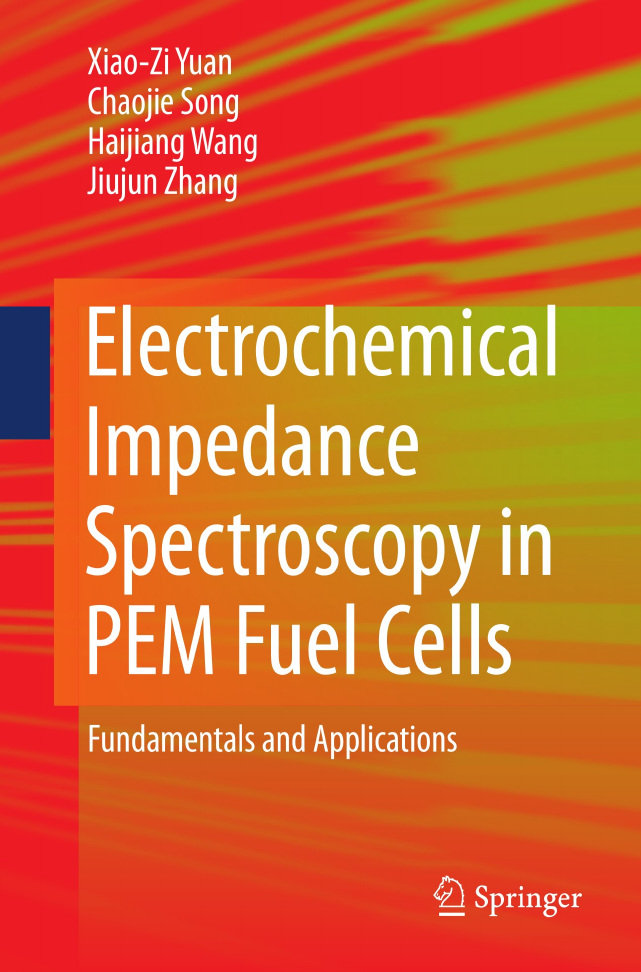
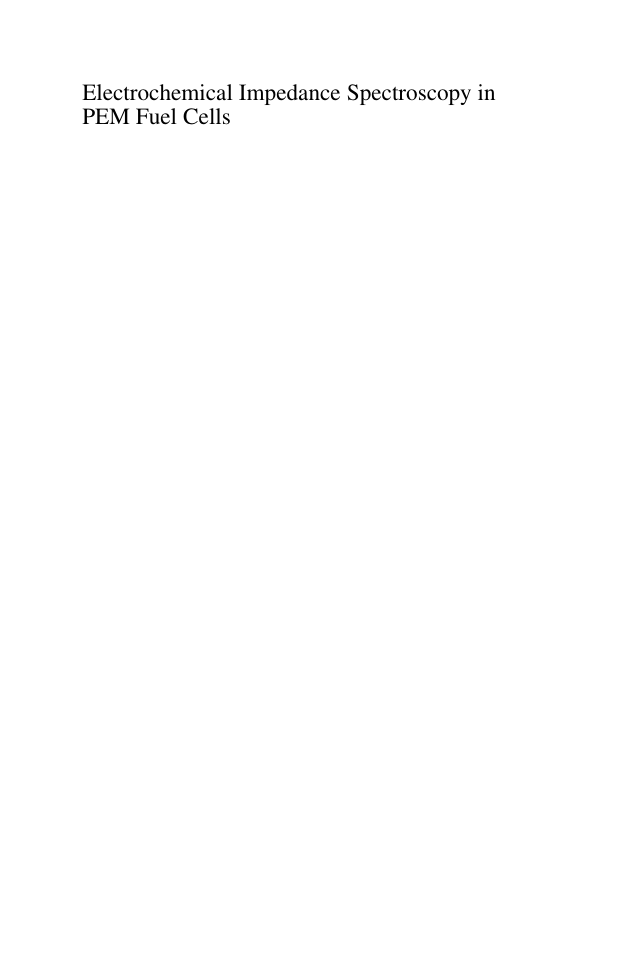

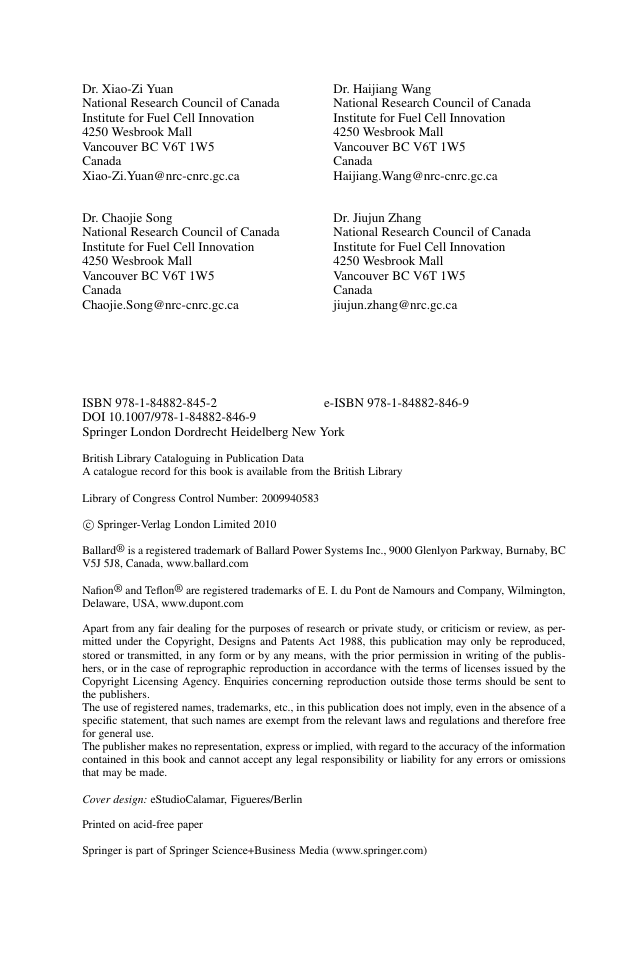
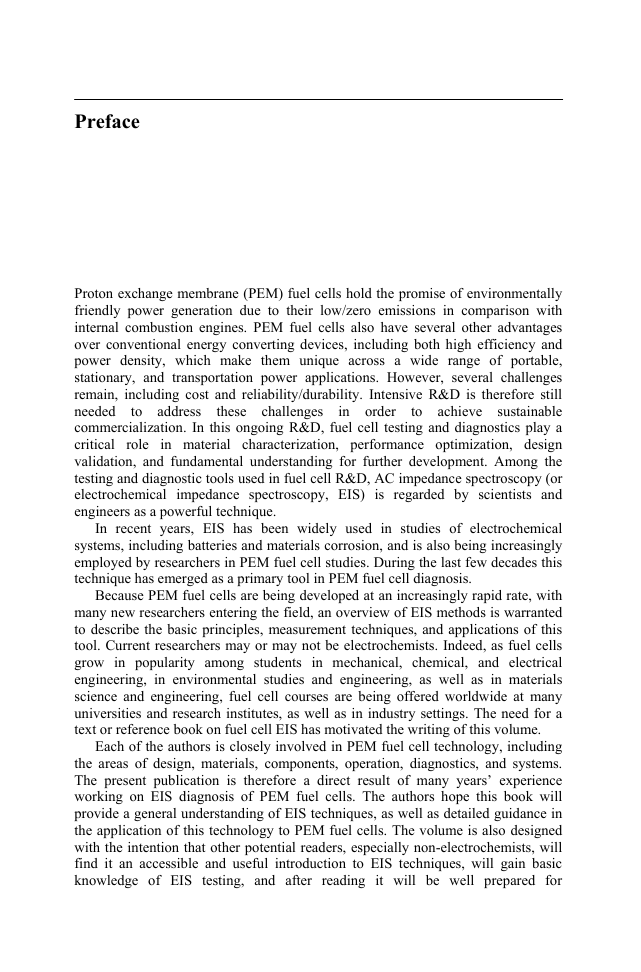
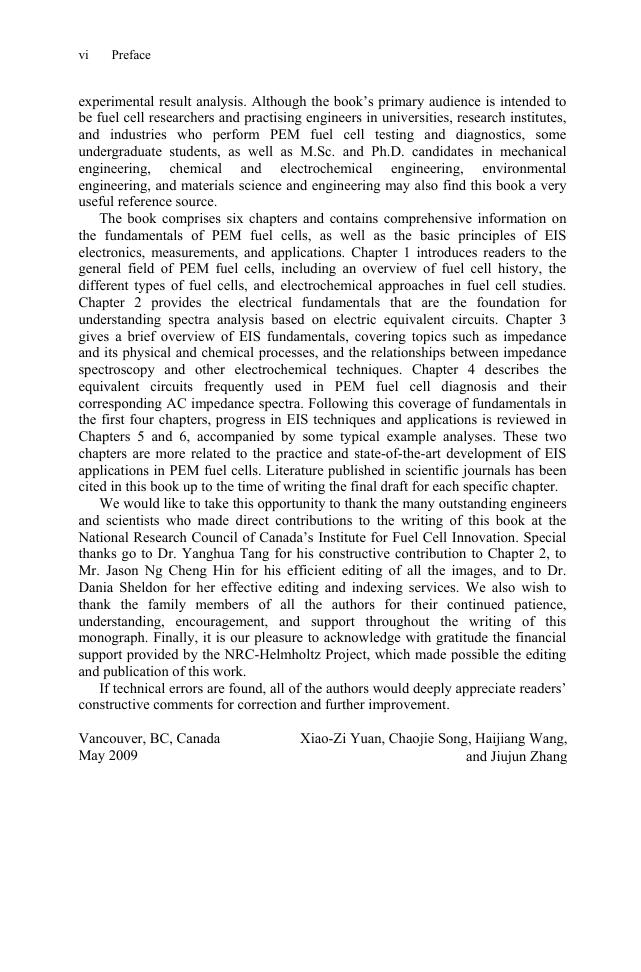

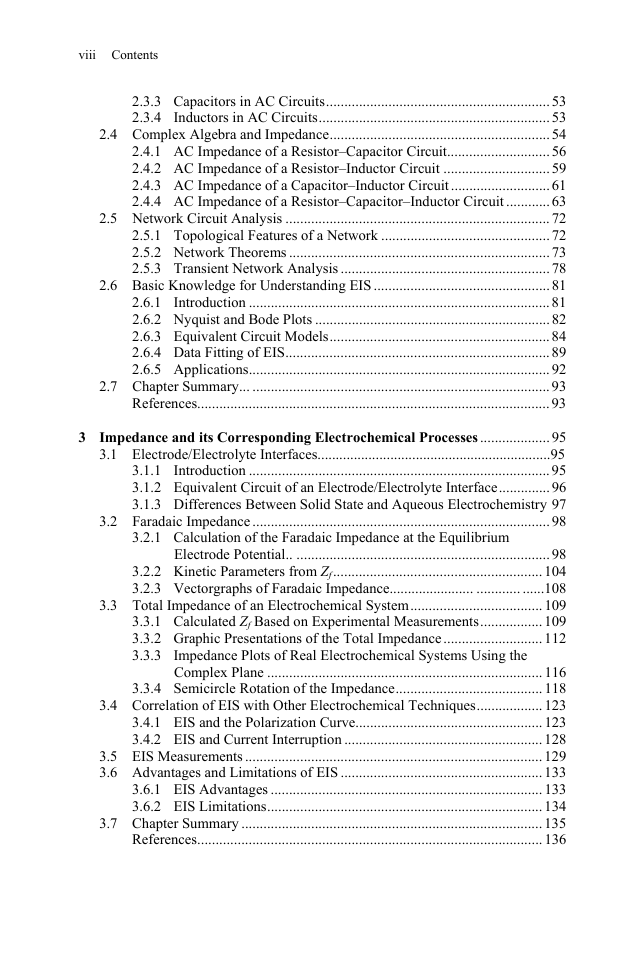








 2023年江西萍乡中考道德与法治真题及答案.doc
2023年江西萍乡中考道德与法治真题及答案.doc 2012年重庆南川中考生物真题及答案.doc
2012年重庆南川中考生物真题及答案.doc 2013年江西师范大学地理学综合及文艺理论基础考研真题.doc
2013年江西师范大学地理学综合及文艺理论基础考研真题.doc 2020年四川甘孜小升初语文真题及答案I卷.doc
2020年四川甘孜小升初语文真题及答案I卷.doc 2020年注册岩土工程师专业基础考试真题及答案.doc
2020年注册岩土工程师专业基础考试真题及答案.doc 2023-2024学年福建省厦门市九年级上学期数学月考试题及答案.doc
2023-2024学年福建省厦门市九年级上学期数学月考试题及答案.doc 2021-2022学年辽宁省沈阳市大东区九年级上学期语文期末试题及答案.doc
2021-2022学年辽宁省沈阳市大东区九年级上学期语文期末试题及答案.doc 2022-2023学年北京东城区初三第一学期物理期末试卷及答案.doc
2022-2023学年北京东城区初三第一学期物理期末试卷及答案.doc 2018上半年江西教师资格初中地理学科知识与教学能力真题及答案.doc
2018上半年江西教师资格初中地理学科知识与教学能力真题及答案.doc 2012年河北国家公务员申论考试真题及答案-省级.doc
2012年河北国家公务员申论考试真题及答案-省级.doc 2020-2021学年江苏省扬州市江都区邵樊片九年级上学期数学第一次质量检测试题及答案.doc
2020-2021学年江苏省扬州市江都区邵樊片九年级上学期数学第一次质量检测试题及答案.doc 2022下半年黑龙江教师资格证中学综合素质真题及答案.doc
2022下半年黑龙江教师资格证中学综合素质真题及答案.doc